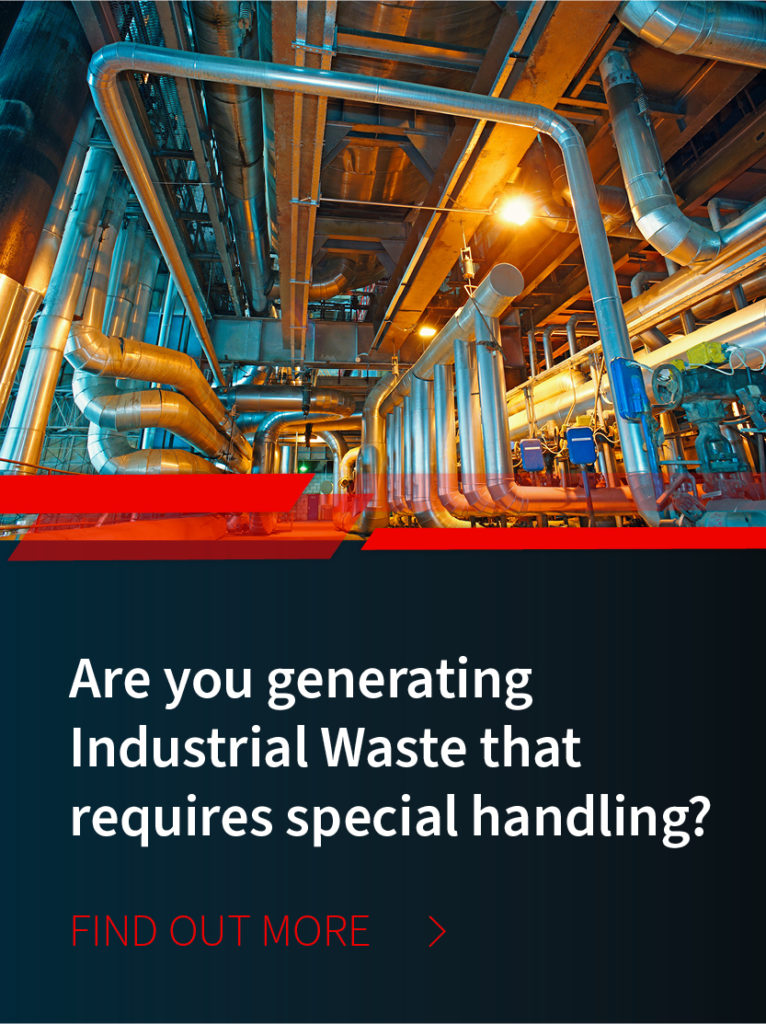
/ IN THIS BLOG
Industrial solid waste, sometimes called just industrial waste or manufacturing waste can be challenging to define. Is it used to define hazardous or non-hazardous waste? The EPA’s Resource Conservation and Recovery Act (RCRA) of 1976 regulates solid waste, and materials that meet the definition of solid waste are subject to additional regulation.Some materials that you might expect to be under the umbrella of solid waste are excluded. For example, materials that might be able to be recycled may be exempt from the label and its regulations. Other reasons a material may be exempt from the designation include a lack of information regarding the material or because it is already regulated under another statute. This can make defining solid waste a more complicated matter.
It’s also important to review your state’s solid waste policy, which can be more stringent (never less) than the federal requirements and may include additional regulations. By knowing exactly which materials produced are considered solid waste, you’ll be able to take steps to properly segregate these materials. In that way you’ll minimize the volume of waste product for which you need to follow regulations for disposal.
01 / What is Industrial Solid Waste?
Solid Waste Doesn’t Need to Be “Solid”
The first thing to know about the term “solid waste” as defined by RCRA is that a waste product doesn’t necessarily have to be in a physically solid state to be referred to by this term. In fact, there are many liquids and semi-solids and even some contained gasses that will fall under the umbrella term of "solid waste" as defined by RCRA. Solid waste can refer to any refuse, sludge or material from “industrial, commercial, mining, and agricultural operations,” according to the EPA. It can also include wastewater as well as waste produced from community activities. The solid waste designation can include both hazardous and non-hazardous substances like fats, oils, and greases.
Solid Waste Is Defined By How It’s Used and Discarded
Another factor that the EPA considers when defining solid waste is how it is discarded. There are four categories that define a solid waste and these are:
Waste that is discarded by being abandoned: Simply put, if the materials are thrown away, burned, incinerated or sham recycled they are deemed abandoned and considered solid waste.
Inherently Waste-like materials are categorized as solid waste: This categorization is for materials that are widely known to be dangerous to the environment and people. For instance, if waste contains dioxin chemicals, it would be listed as Inherently Waste-Like, no matter what other materials are in the waste.
Discarded Military Munitions that are produced or used by the U.S. Department of Defense (DOD) or U.S. Armed Services are automatically listed as solid waste: This includes items used for national defense and security as well as unused or defective munitions that have been abandoned (as defined by the explanation above), made to be non-recyclable or unusable, fired or detonated or classified as waste by authorized military officials.
Finally, solid waste can be materials that are recycled in a specific way: This could be multiple types of scenarios, such a reclaimed material or a material that is reused as an ingredient. Since some recycling activities will exclude a material from being categorized as solid waste it’s important to study the Code of Federal Regulations (CFR) at 40 CFR section 261.4(a).
If a material doesn’t meet these criteria, then it most likely doesn’t need to be classified as solid waste and held to the RCRA regulations. However, because this is such a crucial matter, it’s important to evaluate this on a case by case basis, while also reviewing state requirements.
02 / Exclusions from Solid Waste Regulations
While it’s important to know what constitutes solid waste in the eyes of the EPA, it’s also essential to know what materials have been excluded from this oversight. While this may seem like an additional complication at first glance, these exclusions can help you to reduce the cost of disposal by removing some of the regulation constraints imposed by a solid waste designation. These exclusions have been enacted for a variety of reasons. For instance, some materials may be removed from the solid waste list by an act of Congress, others due to an EPA ruling or even because of the economic impact such a designation would cause.
Some of the materials that have been given an exception to the solid waste designation include domestic sewage, irrigation return flow, radioactive waste, and hazardous secondary materials used to make zinc fertilizers. Based on these examples, it becomes apparent that a full analysis of the exclusion list should be thoroughly reviewed to ensure you are following the appropriate measures. This is especially important to study since the exclusion list is voluminous and requires a detailed inspection. It can be reviewed on the EPA’s overview of solid waste as well as in subsection 40 CFR section 261.4(a).
03 / Hazardous Solid Waste vs. Non-Hazardous Solid Waste
As you can see, there are many areas of RCRA that are complex and a challenge to understand. This is true when it comes to RCRA and hazardous versus non-hazardous waste as well. In some instances hazardous waste is not required to meet the RCRA guidelines, while some non-hazardous waste can be subject to these regulations. Because of the high stakes implications of complying with proper state and federal regulations, it’s wise to consult with a waste management expert who can provide clarity and insight into the ever-changing definitions and guidelines.
So what makes something hazardous? According to the EPA, “a solid waste is a hazardous waste if it is specifically listed as a known hazardous waste or meets the characteristics of a hazardous waste.” The EPA provides four distinct hazardous waste lists:
The F-list covers hazardous waste from common manufacturing and industrial processes
The K-list identifies hazardous wastes from specific industrial and manufacturing sectors
If a solid waste is on one of the four EPA lists, it is automatically considered hazardous. However, there are unlisted hazardous wastes as well, if the waste has one of the following four characteristics:
Ignitability – wastes that can readily catch fire and maintain combustion
Corrosivity – waste that are acidic or alkaline
Reactivity – wastes that reality explode, undergo violent reactions, or react by releasing toxic gasses or fumes
Toxicity – wastes likely to leach dangerous concentrations of toxic chemicals into groundwater
While non-hazardous waste may not be dangerous or toxic, it still cannot be thrown away like normal household trash. Non-hazardous industrial waste can include everything from agricultural waste to construction rubble, batteries to scrap tires. Although it’s not acutely dangerous, non-hazardous waste still may pose a threat to the environment, which is one of the reasons why there are regulations about its disposal.
MCF Environmental Services has the experience and know-how to provide guidance with your waste materials. That’s why businesses trust MCF to handle the disposal of industrial waste, including both hazardous and non-hazardous waste, helping businesses to remain safe, compliant and responsible with the waste their businesses produce.
Robert Losurdo
President, COO








